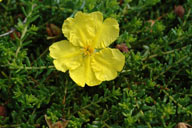In Flower This Week
A weekly news sheet prepared by a Gardens' volunteer.
Numbers before each plant refer to temporary IFTW labels in the gardens.
Numbers in square brackets [ ] refer to garden bed Sections. Plants in flower are in bold type.
View past issues of 'In Flower This Week'.
19 March 2014
Hibbertia serpyllifolia click for larger image |
Today we will walk around the Rock Garden. Either follow the road up the hill past the back of the café or follow the Main Path through the Rainforest Gully to the Rock Garden.
- As you enter the Rock Garden, on your left is Grevillea lanigera [Section 15c], a low bush with grey-green foliage and pink and cream flowers. This grevillea is very long flowering and useful in the garden. It is commonly known as Woolly Grevillea, and is native to Victoria and southeastern New South Wales.
- Further along the path on the right is Grevillea ‘Poorinda Royal Mantle’ [Section 15d], a fast-growing and vigorous groundcover with bright red toothbrush flowers. This plant can cover large areas very quickly.
- On the left is Banksia integrifolia subsp. integrifolia [Section 15c], another vigorous groundcover with dark green leaves that have attractive silver undersides. There are both mature and emerging yellow-green flower heads on this versatile and hardy plant, which is found in coastal areas of eastern Australia.
- On your right is Correa ‘Ivory Bells’ [Section 15d], a very floriferous plant with small dark green leaves and ivory tubular flowers. It is a garden hybrid originally produced in San Francisco, USA, probably by crossing Correa alba and C. backhouseana.
- Also on your right is Chrysocephalum apiculatum [Section 15d] with deep gold button flowers on a small bush of dark green foliage. This daisy is a perennial herb which is found in all states and territories in Australia in a wide range of environments. With such a broad distribution it is not surprising that this species varies considerably in form, from a sparse erect plant to much lower sprawling plants.
- On the right Hibbertia serpyllifolia [Section 15f] has bright gold flowers on fine mid-green foliage.
- As you turn right, look up the path to your left to see Olearia ramulosa var. stricta [Section 15g] on the left, a small slight bush with plenty of white flowers.
- On the left just before you cross the plank bridge is Philotheca linearis [Section 15g], with small white fragrant 5-petalled star flowers with pink centres.
- Turn right after the plank bridge and on the left is Hibbertia vestita [Section 15l], with flat yellow flowers on tiny foliage.
- Further along on the left is Acacia aneura var. aneura [Section 15l], an open bush with needle-like foliage and short fluffy yellow rods of flowers.
- Turn left and on your left is Banksia spinulosa ‘Birthday Candles’ [Section 15l], a dense bright green bush with attractive needle foliage and short yellow flower heads with rusty red styles.
- Turn right down the hill and on your left is a pot of Verticordia pennigera [Section 15r], showing bright pink terminal clusters of fringed flowers on tiny grey-green foliage. Verticordia in Latin means ‘turner of hearts’. Many of the species of this beautiful genus occur in the south-west of Western Australia.
- On your left is Alyogyne ‘West Coast Gem’ [Section 15r] with clear purple ‘hibiscus’-like flowers which open for a short period only but are prolific. The bush is medium-sized with coarse foliage.
- On your left is Eremophila bignoniiflora x E. polyclada [Section 15r] with floppy linear foliage and large tubular lilac-tinged white flowers with spotted throats.
- Turn left along the road to see up to your left the Cliff Bottlebrush, Callistemon comboynensis [Section 15r], in full bloom with prominent red brushes on an upright bush. This plant is native to Queensland and New South Wales.
Rosalind Walcott
![Director of National Parks [logo]](../../../../images/dnp_90px.gif)







